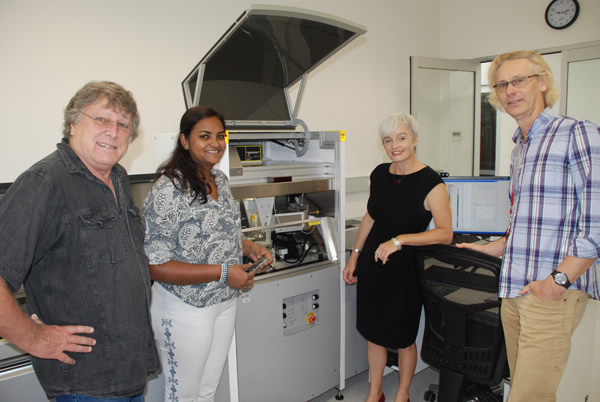Understanding the impact of stressors from human impact on marine ecosystems can be measured with a new approach to biomonitoring using molecular diagnostic tools.
 |
| Prof Emma Johnston with Prof John Dodson, Prof Henk Heijnis and Patricia Gadd |
The application of techniques from molecular diagnostics represents a new approach that can detect and distinguish stressors and subsequently reveal information that is beyond the reach of traditional assessments alone.
DNA sequencing for specific biomarkers is less costly, less labour intensive, faster and more sensitive than established methods of collecting, counting and classifying. When combined with rigorous laboratory and field studies, they can ensure the sensitivity and efficacy of the approach.
According to Prof Emma Johnston, Director of the Sydney Harbour Research Program at the Sydney Institute of Marine Science, this approach has considerably moved forward. She shared highlights of her team’s recent research in a Distinguished Lecture at ANSTO on 12 March.
She has been studying the ecological changes that are occurring in the estuaries of Sydney Harbour and other Australian seaports and bays, which are heavily impacted by human activity.
These areas are subject to multiple stressors, increased salination, contaminants, physical changes to habitats, invasive species that all combine with the natural variability of the environment.
These areas are subject to multiple stressors, increased salination, contaminants, physical changes to habitats, invasive species that all combine with the natural variability of the environment.
Johnston’s team used Sydney rock oysters (Saccostrea glomerata) for a recent study. Oysters are active indicators that can help define a trait or characteristic of a specific environment.
The oysters were exposed to contaminants in the laboratory and experimentally deployed at multiple sites on Australian estuaries with varying levels of contamination.
The oysters were exposed to contaminants in the laboratory and experimentally deployed at multiple sites on Australian estuaries with varying levels of contamination.
The team measured the response of a highly sensitive biomarker, lysosomal membrane stability (LMS), which indicates cell damage to the oysters’ digestive glands. They found a strong association between LMS and exposure to metals such as copper, one of the most abundant contaminants found in polluted estuaries.
During the investigation Johnston’s team found that the response of native and introduced populations to contaminants could be very different.
“Introduced species seems to be highly tolerant to exposure to elevated levels of copper, while native species are often more sensitive to metal pollutants,” said Johnston. “Metals seem to be facilitating biological invasion.“
“Introduced species seems to be highly tolerant to exposure to elevated levels of copper, while native species are often more sensitive to metal pollutants,” said Johnston. “Metals seem to be facilitating biological invasion.“
There were also some surprising results. It is no longer sufficient to measure the levels of a contaminant in an organism or the environment, because the response of an organism to a stressor or may be due to an interaction with other environmental factors.
“What we thought was a response to the presence of copper in sediment, may, in reality, have been due to nutrient enrichment from the carbon in agricultural fertilisers,” said Johnston
Prof Johnston pointed out that a cross-disciplinary approach is needed to understand ‘stress ecology’ and devise mitigation strategies.
Senior research scientist Prof Henk Heijnis, who took Prof Johnston on a tour of ANSTO’s environmental radioactivity laboratory, said that her team’s findings were significant results.
“We have moved from chemistry to biology to biochemistry in understanding the human impact on ecological systems.”
“We have moved from chemistry to biology to biochemistry in understanding the human impact on ecological systems.”
Biomedical scientist Prof Richard Banati said he was looking forward to discussing ANSTO’s work on plastics, microplastics, in particular, molecular diagnostics in the marine environment with Prof Johnston.
Read the research in this publication.
Published: 13/03/2015


